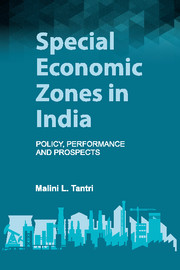Book contents
- Frontmatter
- Contents
- List of Tables, Figures, Charts and Maps
- Preface
- Acknowledgements
- Abbreviations
- 1 Introduction
- 2 Export Processing Zones to Special Economic Zones: Trajectories of Policymaking
- 3 China's Experience with Special Economic Zones under a Liberalized Regime – Highs and Lows
- 4 Performance of Special Economic Zones: Promises, Realizations and Paradoxes
- 5 An Assessment of the Fiscal Viability of Special Economic Zones
- 6 Special Economic Zones and the Question of Efficiency
- 7 Conclusions
- Bibliography
- Index
Preface
Published online by Cambridge University Press: 13 September 2017
- Frontmatter
- Contents
- List of Tables, Figures, Charts and Maps
- Preface
- Acknowledgements
- Abbreviations
- 1 Introduction
- 2 Export Processing Zones to Special Economic Zones: Trajectories of Policymaking
- 3 China's Experience with Special Economic Zones under a Liberalized Regime – Highs and Lows
- 4 Performance of Special Economic Zones: Promises, Realizations and Paradoxes
- 5 An Assessment of the Fiscal Viability of Special Economic Zones
- 6 Special Economic Zones and the Question of Efficiency
- 7 Conclusions
- Bibliography
- Index
Summary
The study has been conceived, designed and carried out in the context of debates and discussions over the introduction of special economic zone (SEZ) policy in the country. The SEZ policy in India, based on the experience of China's SEZs, has been operating in the place of conventional export processing zones (EPZs) in pursuance of the recommendations of the EXIM Policy Statement of 1997–2002. This, in the present context, is considered a powerful instrument for export promotion and therefore, an alternative development strategy. Currently, SEZs have witnessed more than a decade in terms of their expansion in the country while receiving both appreciation and apprehension from different quarters. In this context it is quite necessary to find out whether China's SEZs are as promising as claimed by Indian policymakers or whether there are any issues overlooked while imitating China's model in the Indian context; whether the current SEZ policy merely represents old wine in a new bottle or whether there any new functionalities; how far the existing SEZs have been able to meet the expectations of policymakers; whether there are any basic loopholes still persisting in the current SEZ policy and the way forward. Against this background, this book attempts to evaluate the trajectories of the SEZ policy and its performance in India. Therefore, the main objectives of the study are as follows: first, to look at the Chinese SEZ policy and its varied experience from India's perspective; in particular, to probe whether the Indian policymakers were aware of the nuances of the China's SEZs policy and the various facets of its performance before replicating the same in the Indian context; and second, to understand the different dimensions of the policy and its performance.
The book spreads over seven chapters, starting with an ‘Introduction’. Chapter 2 presents a discussion on the trajectories of the SEZ policy in India. The underpinnings of China's SEZ policy and its growth trajectories are discussed in chapter 3. The issue to what extent the existing SEZs have been able to meet the expectations of the policymakers, both at the aggregate and disaggregate levels, has been explored in chapter 4.
- Type
- Chapter
- Information
- Special Economic Zones in IndiaPolicy, Performance and Prospects, pp. xi - xiiPublisher: Cambridge University PressPrint publication year: 2016



